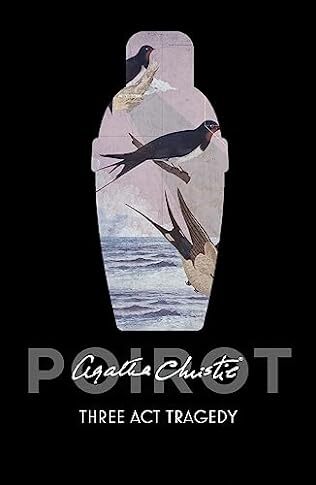Three Act Tragedy

A review of Three Act Tragedy by Agatha Christie – 240101
Some sleuths in detective fiction take to knitting to help them think through the complexities of the case before them (Miss Silver and Mrs Bradley), others take to a pipe (Holmes) or go to the cinema (Bobby Owen) but Christie’s Poirot, the Belgian sleuth with the finely attuned little grey cells, makes houses with cards or, in this case, with a pack of Happy Families. That one he picks out happens to be of the milkman’s wife, Mrs Mug, happens to be particularly germane to the case.
There are many of the ingredients of a classic murder mystery to be found in Three Act Tragedy, also known as Murder In Three Acts, the eleventh in Christie’s Hercule Poirot series originally published in 1934. There are house parties, a motley collection of guests, a suspicious butler who goes missing, mysterious deaths which look like accidents, the use of an unusual poison, nicotine, which can be distilled from a common or garden product, rose feed, and plenty of twists and turns to keep the reader on their toes. It is great fun, although Christie is more concerned about keeping the plot moving rather than developing her characters who come across as rather lifeless.
The book is structured into three Acts, a homage to the fact that one of the principal characters, Sir Charles Cartwright, is a doyen of the stage. The first act, Suspicion, deals with the aftermath of a dinner party hosted by Sir Charles in Cornwall in which a vicar, the Reverend Babbington, dies suddenly after drinking a cocktail. While the host believes it to have been foul play, the other guests, including Poirot, conclude that it was an accident, especially as no evidence of poison was found in the glass.
That Sir Charles’ suspicions are well founded becomes apparent in the second Act, Certainty, when news arrives in Monaco of another sudden death, this time of Sir Charles’ friend, Dr Bartholomew Strange, who dies suddenly after drinking a glass of port at a party attended by most of the guests of the first event. The third Act, Discovery, deals with the investigations and ultimately the unravelling of motive and the identification of the culprit.
Sir Charles plays a leading role in the investigation, aided by Mr Satterthwaite, who had appeared in various of Christie’s short stories, a flighty all-action young woman, Hermione Lytton Gore, aka Egg, who has a pash for Sir Charles, and, of course, Poirot. To Egg’s dismay Poirot’s preferred approach is to sit back and mull over the intricacies of the case. When he finally bestirs himself, only to find that a supposedly important witness confined to a sanitorium, Mrs de Rusbridger, has also died in mysterious circumstances, and hot foots it down to Cornwall to observe the activities of Sir Charles’ secretary, Miss Milray, he is able to piece the clues together and come up with an astonishing conclusion.
The reader, if they have come to this story for the first time, would be hard pushed to anticipate the motivation for the crimes, even if they had an inkling as to the identity of the killer, and on reading the final pages will probably conclude that it was a preposterous amount of effort to go to when there were other easier and less dangerous ways of resolving a set of circumstances in which the culprit had found themselves. Still, there would not have been a story to tell then. The replacement of the poisoned glasses with clean glasses requires a feat of legerdemain that might just have been possible and the poor vicar, the motivation for whose death baffles even the great Poirot, is little more than the victim of a dress rehearsal. As Poirot says at the end, it could have been him.
While not the best in the Poirot canon, there is much to enjoy in Christie’s storytelling, even if the seams of the plot are in danger of falling apart at times.



